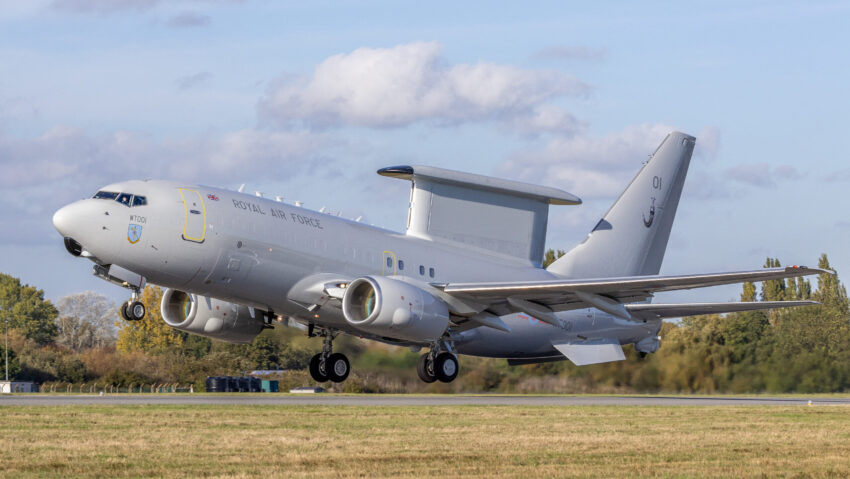The UK’s E-7 Wedgetail Airborne Early Warning (AEW) aircraft is set to belatedly reach an initial operational capability milestone next year (Royal Air Force)
BELFAST — The build of a first UK E-7 Wedgetail Airborne Early Warning (AEW) aircraft is “nearing completion,” and the platform remains in line to “detect a range of missile threats towards” Britain once operational, despite the recent decision by the US Air Force to cancel its own Wedgetail effort, a spokesperson for the UK MoD told Breaking Defense.
The spokesperson added that the first of three aircraft on order from Boeing “will soon begin a comprehensive ground and flight test programme prior to the aircraft being handed over to the Royal Air Force.”
Boeing UK declined to comment on the potential impact of the Air Force cancellation decision — which was made in light of soaring costs and survivability concerns — and deferred flight test questions to the UK MoD.
In all, the estimated £1.89 billion ($2.57 billion) British E-7 program had completed a total of three test flights as of May, according to a parliamentary statement from Maria Eagle, UK defense procurement minister. She also noted that an “exact number” of flight tests to be completed “depends upon the success” of each one.
Douglas Barrie, senior fellow for military aerospace at the UK-based International Institute for Strategic Studies (IISS) think tank, told Breaking Defense that the Air Force cancellation would likely not prompt any changes to forthcoming flight tests and Wedgetail entry to service for the Royal Air Force (RAF), because scrapping the UK procurement and opting for a new one amounts to an “extraordinary waste of money.”
Despite an original plan to field the aircraft in the “early” 2020s, it was revealed last year that Wedgetail is to belatedly meet an initial operational capability milestone in 2026.
“The E7 capability, which is a vital early-warning capability, is late, and they have had real technical and delivery issues within Boeing in delivering that aircraft,” Andy Start, CEO of Defence Equipment and Support, the UK procurement agency, told the Public Accounts Committee last year.
Lawmakers have been critical of the troubled aviation program, with several asserting in a 2023 report that the acquisition “represents extremely poor value for money.” But the UK’s recently published Strategic Defence Review recommended ordering more aircraft, dependent on funding opening up.
The UK originally signed a $1.98 billion contract with Boeing for the procurement of five aircraft to replace E-3D Sentry platforms, before committing to a reduced buy of three units on cost grounds. It has also agreed to pay for all five of the Northrop Grumman Multi-Role Electronically Scanned Array (MESA) radars, so the two additional sensors can be used as spares.
“There’s always been a recognition that three [aircraft] is not enough,” said Barrie. When the range of E-7 operations are considered, including air support for Ballistic Missile Submarines he said, “five aircraft was the absolute minimum that could actually cover … what you needed to do, ideally, seven would have been good.”
Based off the commercially produced 737 Next Generation airliner, conversion work on the RAF Wedgetails takes place at STS Aviation Services facility in Birmingham Airport, England. The new fleet will be operated by RAF 8 Squadron, based out of Lossiemouth, Scotland.
“The combat-proven E-7 detects and identifies adversarial targets at long range and tracks multiple airborne and maritime threats simultaneously with 360-degree coverage” through the MESA radar, according to Boeing.
Click this link for the original source of this article.
Author: Tim Martin
This content is courtesy of, and owned and copyrighted by, https://breakingdefense.com and its author. This content is made available by use of the public RSS feed offered by the host site and is used for educational purposes only. If you are the author or represent the host site and would like this content removed now and in the future, please contact USSANews.com using the email address in the Contact page found in the website menu.








